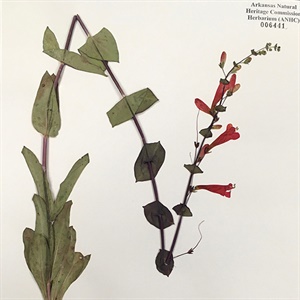updated from a 2013 Department of Arkansas Heritage Storyline article
Books are stored, cataloged, and organized for reference in a library. A herbarium, like a library, is a collection of preserved plants that are stored, cataloged and arranged systematically for study. The Arkansas Natural Heritage Commission (ANHC) maintains one of eight herbaria in the state recognized by the Index Herbariorum (IH), the official database of worldwide herbaria.
The practice of pressing and drying plants has been used for more than 500 years. Thanks to this simple technique, most of the characteristics of living plants are visible on the dried plant. The few that are not (e.g. flower color, scent, height of a tree, vegetation type, etc.) are recorded by the collector and printed on a label which is attached to a sheet with the dried plant. The specimens stored in the herbarium are a working reference collection, and each plant specimen has its own unique information – where it was found, when it flowers, and what it looks like. Herbarium specimens allow botanists to study fine morphological details and retrieve tissues for genetic studies, both of which are used in taxonomic research (scientific classification according to natural relationships).
Only those collections that are permanent scientific repositories are included in the IH, which is maintained by the New York Botanical Garden. In order to be a recognized herbarium, a site must maintain a collection of specimens, which are accessible to scientists, and actively managed. As a recognized herbarium, the ANHC is able to loan out specimens to researchers at other institutions for study. Botanists at the ANHC herbarium also borrow specimens from other herbaria, allowing them to study specimens from other collections.
The ANHC herbarium has been recognized by the IH since 2003 and it currently contains 15,100 specimens. Approximately 17 percent are tracked, rare plants. The oldest specimen in the ANHC herbarium, collected in 1941 by Delzie Demaree, is Sabatia campanulata (slender rose-gentian).
The ANHC herbarium is in the process of imaging and cataloging every specimen for a digital version of the herbarium. Although nothing would equal the detail and value of studying the actual specimens, a digital catalog would allow anyone to view the specimens at any time, from anywhere.
Books are stored, cataloged, and organized for reference in a library. A herbarium, like a library, is a collection of preserved plants that are stored, cataloged and arranged systematically for study. The Arkansas Natural Heritage Commission (ANHC) maintains one of eight herbaria in the state recognized by the Index Herbariorum (IH), the official database of worldwide herbaria.
The practice of pressing and drying plants has been used for more than 500 years. Thanks to this simple technique, most of the characteristics of living plants are visible on the dried plant. The few that are not (e.g. flower color, scent, height of a tree, vegetation type, etc.) are recorded by the collector and printed on a label which is attached to a sheet with the dried plant. The specimens stored in the herbarium are a working reference collection, and each plant specimen has its own unique information – where it was found, when it flowers, and what it looks like. Herbarium specimens allow botanists to study fine morphological details and retrieve tissues for genetic studies, both of which are used in taxonomic research (scientific classification according to natural relationships).
Only those collections that are permanent scientific repositories are included in the IH, which is maintained by the New York Botanical Garden. In order to be a recognized herbarium, a site must maintain a collection of specimens, which are accessible to scientists, and actively managed. As a recognized herbarium, the ANHC is able to loan out specimens to researchers at other institutions for study. Botanists at the ANHC herbarium also borrow specimens from other herbaria, allowing them to study specimens from other collections.
The ANHC herbarium has been recognized by the IH since 2003 and it currently contains 15,100 specimens. Approximately 17 percent are tracked, rare plants. The oldest specimen in the ANHC herbarium, collected in 1941 by Delzie Demaree, is Sabatia campanulata (slender rose-gentian).
The ANHC herbarium is in the process of imaging and cataloging every specimen for a digital version of the herbarium. Although nothing would equal the detail and value of studying the actual specimens, a digital catalog would allow anyone to view the specimens at any time, from anywhere.
